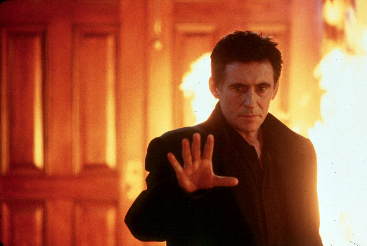

The first recorded incident of stigmata occurred with St. Francis of Assisi, a devout Catholic. Stigmata are the wound that occur in very devout Catholics that resemble the wounds of Christ when he was crucified. Wounds develop in the arms, legs, forehead, and side of the body. In total, the Catholic Church has documented only a couple hundred cases where they declared the event genuine. So when Frankie Paige (Patricia Arquette from Lost Highway and Goodbye Lover), atheist hairdresser (let the world beware!) begins to develop signs that are similar to stigmata, Father Andrew Kiernan (Gabriel Byrne, Enemy of the State and a forthcoming seemingly similarly themed film End of Days) is sent in to investigate.
Stigmata begins in South America, with Kiernan investigating a bleeding statue of the Virgin Mary. A funeral for the local priest is taking place the same time he is snapping pictures of the statue. Meanwhile, someone steals the dead priest's rosary, and sells it to an American tourist. Upon his return to Italy, his superior, Cardinal Houseman (Jonathan Pryce, Evita, Tomorrow Never Dies) stops his investigation, although Kiernan wants to return. Obviously, Houseman is the bad guy. When a subway video from America shows up showing what possibly may be a demonic attack, Houseman sends Kiernan to look into the matter. Kiernan believes that Houseman is merely trying to send him away on a worthless assignment. Paige is the woman in the video, and Kiernan initially refuses to help after finding out she isn't Catholic. After all, if she isn't Catholic, then it isn't stigmata. As the attacks on Paige continue, she is increasingly alienated from her friends (Nia Long of In Too Deep, and Portia de Rossi of Ally McBeal), Kiernan becomes more concerned. It turns out that Paige's mother is the tourist who bought the rosary, and then sent it to Paige as a gift. Rade Serbedgia (Eyes Wide Shut) has a small but good role, crucial to the outcome of the movieNot so surprisingly, certain elements of the Catholic Church are portrayed negatively. Surprisingly, the Kiernan character (a scientist who works for the Vatican in a Dana Scully type role) is not a stereotypical Christian. He is human, but all of his actions and thoughts are a result of his love for God. In his conversations with Paige, he describes why he believes in God, and what it means to him. It is a refreshing view not often present in today's movies. Many of the issues raised in Stigmata have at one time been relevant issues in the Church, though one of the larger ones is a moot point for the Protestant church. Director Rupert Wainwright and screenwriter Tom Lazarus (a veteran of many television series) incorporate the element of stigmata and Canon and non-Canonical gospels in an interesting manner to form a very cohesive plot.
Director Wainwright has a background in commercials, and it shows in the movie. Stigmata is not quite a horror movie, but there is a lot of blood. Every time Paige is 'attacked,' scenes are quickly interspliced showing in great detail spikes being driven into palms, whips lashing a back, and a crown of thorns being placed on a head. Many sets within the film evoke a neo-gothic atmosphere. Paige's apartment is awash with candles. The libraries and offices of the Vatican are dark and ominous. Many buildings and rooms are similarly dark, with stray rays of light providing the lighting. All of this works very effectively in quickly moving the story to its big, almost action movie type ending.